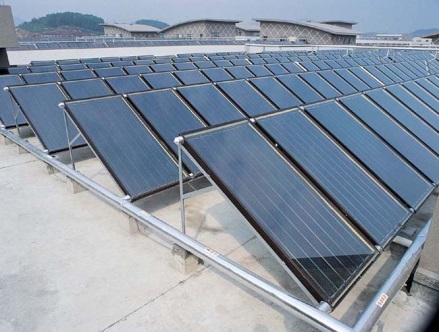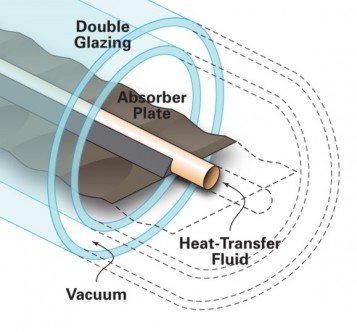Thermal
DEFINITION & TYPES OF STRATEGIES
Solar thermal energy uses solar thermal collector. These devices collect heat by absorbing solar radiation.The produced heat can be used for multiple activities like cooking or producing warm water for human’s consumption, sanitary water, heating, or electricity.
It can be used for an absorption cooling device that works with heat and non with electricity to produce cold which can be used for local air conditioning.
Solar power plants usually use the more complex collectors to generate electricity by heating a fluid to drive a turbine connected to an electrical generator.
On the other hand, in residential and commercial buildings for space heating is better to use simple collectors.
Sola thermal energy in houses:
Types of Thermal collectors
Low temperature collectors
They are used for space heating, domestic hot water or cooling with an absorption chiller.There are different kinds of low temperature collectors:
FLAT PLATE COLLECTORS
The main use of flat plate collectors is in residential buildings where the demand for hot water has a large impact on energy bills. Commercial applications include laundromats, car washes, military laundry facilities and eating establishments. These collectors can also be used for space heating if the building is located off-grid or if utility power is subject to frequent outages.
Unglazed liquid collectors are commonly used to heat water for swimming pools but can also be applied to large scale water pre-heating. Flat plate collectors are generally comprised of a series of copper pipes in a very well insulated glass box. Sunlight strikes the glass, and the heat is trapped and held inside by heavy insulation. As water or a heat transfer fluid is passed through the collector, the heat trapped from the sun is transferred into the fluid. This fluid is heated, and circulated back through a heat exchanger, where the heat is stored for immediate or later use in domestic hot water or space heating systems.

EVALUATED TUBE COLLECTORS
While evacuated tube technology clearly surpasses flat panels for nearly all water heating applications, the advantages are truly dramatic when used for solar air conditioning, heating or commercial process. That’s because evacuated tube heat pipe collectors can more easily attain the higher temperatures needed, they can collect and retain heat even when it is very cold outside, and due to their superior Incidence Angle Modifier they collect solar energy more evenly throughout the day resulting in a lower buffer or thermal storage requirement. Each tube works independently from the others, and is surrounded by a double wall tube of glass. In between the double walls is a deep vacuum, producing a “thermos” effect which greatly increases its thermal insulation. This design allows the sunlight to pass through the glass, but allows very little heat to escape.
Evacuated tube collectors can satisfy even large heating demands and are used by customers seeking more sustainable and cost-saving alternatives.

Medium temperature collectors
Medium temperature collectors are most widely used for residential and commercial water heating, with smaller uses for pool and space heating.
SOLAR DRYER
Solar thermal energy can be useful for drying wood for construction and fuel wood. It is also used to dry foods such as fruits, grains and fish. Drying of crops by means of solar thermal energy is environmentally friendly as well as economic while improving the quality of the result.
High temperature collectors
The efficiency of heat engines increases with the temperature of the heat source. To achieve this in thermal power plants, solar radiation is concentrated by mirrors or lenses to achieve high temperatures using a technique called concentration solar electricity (in English: Concentrated Solar Power, CSP). With the current technology, heat storage is much cheaper than electricity storage. In this way, a CSP plant could produce electricity during the day and night. If the location of the CSP plant has predictable solar radiation, then the plant becomes a reliable power generation plant. Reliability can be improved even more by installing a backup system that uses a system of internal combustion. This backup system can use most of the facilities of the CSP plant, which makes lower cost of backup system.
Parabolic troughs, dishes and towers are used almost exclusively in solar power generating stations or for research purposes.
PARABOLIC TROUGHS
This type of collector is generally used in solar power plants. A trough-shaped parabolic reflector is used to concentrate sunlight on an insulated tube (Dewar tube) or heat pipe, placed at the focal point, containing coolant which transfers heat from the collectors to the boilers in the power station.
This type of collector is generally used in solar power plants. A trough-shaped parabolic reflector is used to concentrate sunlight on an insulated tube (Dewar tube) or heat pipe, placed at the focal point, containing coolant which transfers heat from the collectors to the boilers in the power station.

PARABOLIC DISH
With a parabolic dish collector, one or more parabolic dishes concentrate solar energy at a single focal point. This geometry may be used in solar furnaces and solar power plants.
The shape of a parabola means that incoming light rays which are parallel to the dish’s axis will be reflected toward the focus, no matter where on the dish they arrive. Light from the sun arrives at the Earth’s surface almost completely parallel. So the dish is aligned with its axis pointing at the sun, allowing almost all incoming radiation to be reflected towards the focal point of the dish.

POWER TOWER
A power tower is a large tower surrounded by tracking mirrors called heliostats. These mirrors align themselves and focus sunlight on the receiver at the top of tower, collected heat is transferred to a power station below. This design reaches very high temperatures. High temperatures are suitable for electricity generation using conventional methods like steam turbine or a direct high temperature chemical reaction such as liquid salt.

TREND
Developments in solar thermal technology have made these systems more reliable and more efficient and, therefore, a more practical choice for prospective adopters.
If we considerate Concentrated Solar Power, the IPPC have estimated that an “ installed capacity of 21.5 GWe, if reached by 2020, would produce 54.6 TWh/yr with a further possible increase leading towards 5% coverage of world electricity demand by 2040
Efforts in solar thermal energy must be focused on using this kind of energy in homes because it is a good way to save money, water, and environmental impact.
In addition, suitable places where the surfaces of the Earth reach a big amount of sunlight must be used to installing solar thermal collectors. In this way, more efficiency is achieved
